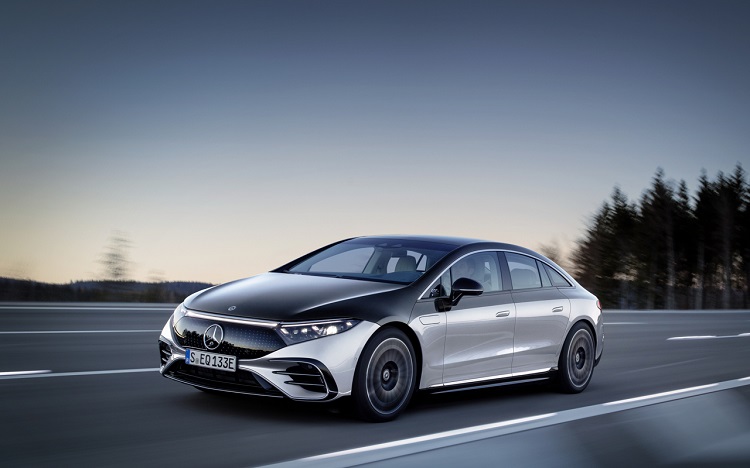The EQS is the first all-electric luxury sedan from Mercedes-EQ. With it, Mercedes-EQ is redefining this vehicle segment. The EQS is also the first model to be based on the modular architecture for luxury and executive-class electric vehicles. Fusing technology, design, functionality and connectivity, the EQS delights both drivers and passengers. First models on the market will be the EQS 450+ with 245 kW (electrical consumption NEDC combined: 19.1-16.0 kWh/100 km; CO2-emissions: 0 g/km) and the EQS 580 4MATIC with 385 kW (electrical consumption NEDC combined: 20.0-16.9 kWh/100 km; CO2-emissions:
0 g/km). The consumption figures according to WLTP: EQS 450+ electrical consumption combined
20.4-15.7 kWh/100 km, CO2-emissions 0 g/km; EQS 580 4MATIC electrical consumption combined
21.8-17.4 kWh/100 km, CO2-emissions 0 g/km.
As part of its Ambition 2039 initiative, Mercedes-Benz is working on offering a carbon-neutral new car fleet within 20 years from now. By as early as 2030, the company wants more than half the cars it sells to feature electric drive systems – this includes fully electric vehicles and plug-in hybrids. In many areas, Mercedes is already thinking about tomorrow today: the new EQS is designed to be correspondingly sustainable. The vehicles are produced in a carbon-neutral manner, and resource-saving materials such as carpets made from recycled yarn are used. This is because Mercedes-Benz considers the entire value chain, from development and the supplier network to its own production. Mercedes-Benz AG has had its climate protection targets confirmed by the Science Based Targets Initiative (SBTI).
With a great deal of meticulous detail work and on the basis of the Purpose design, the aerodynamicists, in close cooperation with the designers, were able to achieve a new cd best value of 0.20. This makes the EQS the most aerodynamic production car in the world. The operating range particularly benefits from this. It is also among the best in terms of quiet running. The very low wind noise level contributes significantly to this.
The EQS also currently sets a very good value for recuperation: Of the maximum deceleration in the DAuto recuperation program of 5 m/s², up to 3 m/s² is achieved by recuperation (2 m/s² by the wheel brakes). This allows decelerating to a standstill without using the brake pedal, while at the same time the range benefits from this recuperation strategy and the high recuperation power (up to 290 kW). Deceleration is also applied to detected vehicles ahead until they come to a standstill, for example at traffic lights. Intelligent energy recovery is situation-optimised with the aid of ECO Assist and acts with foresight, taking into account traffic conditions or topography, among other things. The driver also can set three energy recovery levels and the coast function via paddle shifters on the steering wheel.
With ranges up to 770 kilometres (WLTP) and an output of up to 385 kW the powertrain of the EQS also meets every expectation of a progressive sedan in the S-Class segment. A performance version with up to 560 kW is being planned. All EQS models have an electric powertrain (eATS) at the rear axle, while the versions with 4MATIC also have an eATS at the front axle.
The EQS marks the launch of a new generation of batteries with significantly higher energy density. The larger of the two batteries has a usable energy content of 107.8 kWh. That is around 26 percent more than the EQC (EQC 400 4MATIC: combined electrical consumption: 21.5-20.1 kWh/100 km; CO2 emissions: 0 g/km). The innovative battery management software, developed in-house, allows updates over the air (OTA). In this way, the energy management system remains up to date throughout the life cycle. In terms of the cell chemistry, the cobalt content of the cathodes has been reduced to ten percent.
The EQS can be charged with up to 200 kW at fast charging stations with direct current. Power for up to another 300 kilometres (WLTP) is recharged in just 15 minutes. At home or at public charging stations, the EQS can be conveniently charged with up to 22 kW with AC using the on-board charger. In addition, there are various intelligent charging programs that can be activated automatically depending on the location, and functions such as particularly battery-saving charging.





